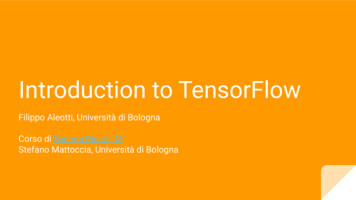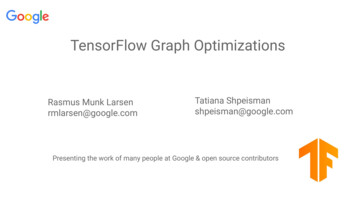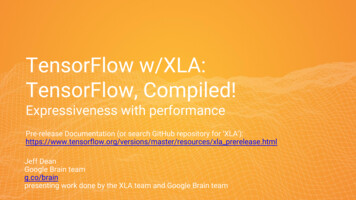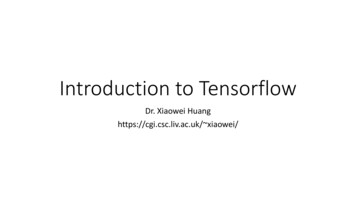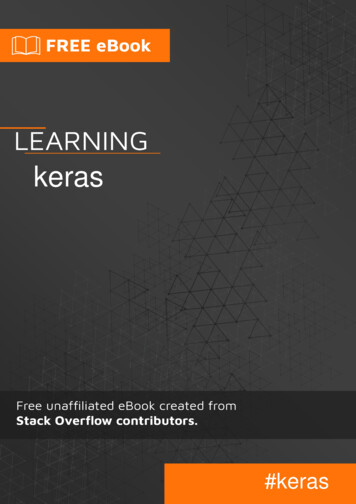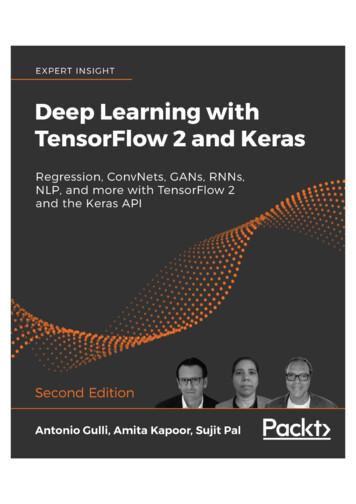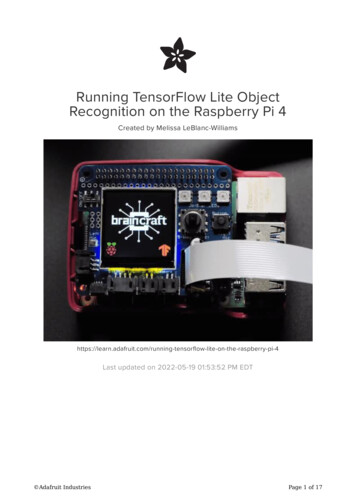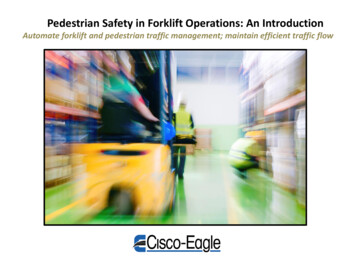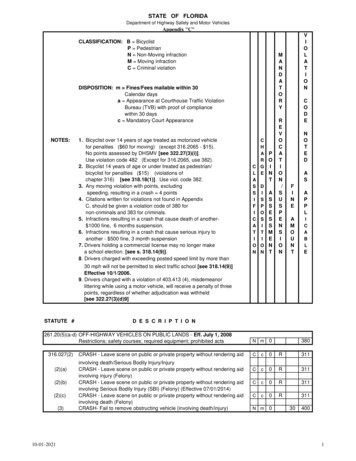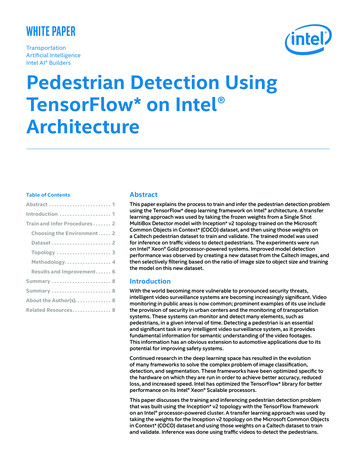
Transcription
white paperTransportationArtificial IntelligenceIntel AI BuildersPedestrian Detection UsingTensorFlow* on Intel ArchitectureTable of ContentsAbstractAbstract . . . . . . . . . . . . . . . . . . . . . . . . . 1This paper explains the process to train and infer the pedestrian detection problemusing the TensorFlow* deep learning framework on Intel architecture. A transferlearning approach was used by taking the frozen weights from a Single ShotMultiBox Detector model with Inception* v2 topology trained on the MicrosoftCommon Objects in Context* (COCO) dataset, and then using those weights ona Caltech pedestrian dataset to train and validate. The trained model was usedfor inference on traffic videos to detect pedestrians. The experiments were runon Intel Xeon Gold processor-powered systems. Improved model detectionperformance was observed by creating a new dataset from the Caltech images, andthen selectively filtering based on the ratio of image size to object size and trainingthe model on this new dataset.Introduction . . . . . . . . . . . . . . . . . . . . . 1Train and Infer Procedures. . . . . . . . 2Choosing the Environment. . . . . . 2Dataset . . . . . . . . . . . . . . . . . . . . . . . . 2Topology . . . . . . . . . . . . . . . . . . . . . . 3Methodology. . . . . . . . . . . . . . . . . . . 4Results and Improvement. . . . . . . 6Summary . . . . . . . . . . . . . . . . . . . . . . . . 8IntroductionSummary . . . . . . . . . . . . . . . . . . . . . . . . 8With the world becoming more vulnerable to pronounced security threats,intelligent video surveillance systems are becoming increasingly significant. Videomonitoring in public areas is now common; prominent examples of its use includethe provision of security in urban centers and the monitoring of transportationsystems. These systems can monitor and detect many elements, such aspedestrians, in a given interval of time. Detecting a pedestrian is an essentialand significant task in any intelligent video surveillance system, as it providesfundamental information for semantic understanding of the video footages.This information has an obvious extension to automotive applications due to itspotential for improving safety systems.About the Author(s). . . . . . . . . . . . . . 8Related Resources. . . . . . . . . . . . . . . . 8Continued research in the deep learning space has resulted in the evolutionof many frameworks to solve the complex problem of image classification,detection, and segmentation. These frameworks have been optimized specific tothe hardware on which they are run in order to achieve better accuracy, reducedloss, and increased speed. Intel has optimized the TensorFlow* library for betterperformance on its Intel Xeon Scalable processors.This paper discusses the training and inferencing pedestrian detection problemthat was built using the Inception* v2 topology with the TensorFlow frameworkon an Intel processor-powered cluster. A transfer learning approach was used bytaking the weights for the Inception v2 topology on the Microsoft Common Objectsin Context* (COCO) dataset and using those weights on a Caltech dataset to trainand validate. Inference was done using traffic videos to detect the pedestrians.
White Paper Pedestrian Detection Using TensorFlow* on Intel ArchitectureTrain and Infer ProceduresThis section describes in detail the steps we used to train and infer the pedestrian detection problem.Choosing the EnvironmentHardware ConfigurationIntel has launched its new and faster Intel Xeon Gold processor powered system and the experiments are performed on thissystem.The details of the hardware for the Intel Xeon Gold processor powered system used for the experiments are listed in thefollowing Table 1:Architecturex86 64CPU op-mode(s)32 bit, 64 bitByte orderLittle endianCPU(s)24Core(s) per socket6Socket(s)2CPU family6Model85Model nameIntel Xeon Gold 6128 processor@ 3.40 GHzRAM92 GBTable 1. Intel Xeon Scalable Gold processor configuration.Software ConfigurationThe TensorFlow framework optimized for Intel architecture and the Intel Distribution for Python* were used as the softwareconfiguration, as shown in Table 2.TensorFlow*1.3.0 (Intel optimized)Python*3.5.3 (Intel distributed)Table 2. Software configuration for the Intel Xeon Gold processor.The software configurations are available on the hardware environments chosen, and no source build for TensorFlow*AI wasnecessary.TensorFlow Object Detection APIThe TensorFlow Object Detection API was used, which an open source framework is built on top of TensorFlow that makesit easy to construct, train, and deploy object detection models. This API was used for the experiments on the pedestriandetection problem.DatasetWe chose the Caltech Pedestrian Dataset1 for training and validation. This dataset consisted of approximately 10 hours of640x480 30-Hz video that was taken from a vehicle driving through regular traffic in an urban environment. To accommodatemultiple scenarios, about 250,000 frames (in approximately 137 one-minute-long segments) with a total of 350,000 boundingboxes and 2,300 unique pedestrians were annotated.2
White Paper Pedestrian Detection Using TensorFlow* on Intel ArchitectureThe dataset consisted of the following elements: A list of bounding boxes for the image. Each bounding box contained: Bounding box coordinates (with the origin in the upper-left corner) defined by four floating point numbers such as,[ymin, xmin, ymax, xmax]. We stored the normalized coordinates (x / width, y / height) in the TFRecord dataset. The class of the object in the bounding box. The dataset was organized into six training sets and five test sets. Each set consisted of 6‒13 one-minute-long .seq files with annotations in .vbb file format. An RGB image was encoded for the dataset as jpeg.TopologyThe Inception architecture was built with the intent of improving the use of computing resources inside a deep neural network.The main idea behind Inception is the ability to approximate a sparse structure with spatially repeated dense componentsand use dimension reduction like those used in a “network in network” architecture to keep the computational complexity inbounds, but only when required. The computational cost of Inception is also much lower than that of other topologies. Moreinformation on Inception is given in this paper2. Figure 1 shows the Inception architecture.Figure 1. GoogLeNet* Inception* model. 3Inception v2 has a slight structural change in the Inception module. Figure 2 shows the Inception v2 module structure.Figure 2. Inception* v2 module. 3To accelerate the training process, we applied a transfer learning technique by using the pretrained Inception v2 model fromGoogLeNet* on the COCO dataset. The pretrained model had already learned the knowledge on the data and stored that inthe form of weights. These weights were directly used as initial weights and readjusted when the model was retrained on theCaltech dataset.The pretrained model (265MB) was downloaded from the following link : ion/ssd inception v2 coco 2017 11 17.tar.gz3
White Paper Pedestrian Detection Using TensorFlow* on Intel ArchitectureMethodologyThis section covers the steps we followed to train and infer pedestrian detection on Intel architecture.These steps included: Preparing the input Training the model Experimental runs and inferencePreparing the InputTFRecord FormatTo use the pedestrian dataset in TensorFlow Object Detection API, it must be converted into the TFRecord file format. Readingdata from the TFRecord file is much faster in TensorFlow than reading from other image formats.The Caltech dataset consisted of images in the jpg format and their corresponding annotations in XML format.To convert the dataset into TFRecord format, we did the following:1.Images from the .seq files were extracted into an Images folder.2.The annotations from the corresponding .vbb files were extracted into an annotations folder.The following code was used to convert the Caltech dataset into TFRecord format:DATASET DIR ./CALTECH/train/OUTPUT DIR ./tfrecordspython tf convert data.py \--dataset name caltech \--dataset dir {DATASET DIR} \--output name caltech tfrecord \--output dir {OUTPUT DIR}Label MapEach dataset is required to have an associated label map. This label map defines a mapping from string class names to integerclass Ids. The label created for pedestrian was as follows.item {id: 1name: 'person'}Configuring Training PipelineThe TensorFlow Object Detection API uses protobuf files to configure the training and evaluation process. The configurationfile is structured into five sections. The required sections were used as appropriate. The changes to be done in each sectionare as below.1. model section, set the num classes to one (num classes: 1). For the pedestrian detection only one class has to bedetected.2. train config section, set the checkpoint file with the path. (fine tune checkpoint: " /research/object detection/models/model/ssd inception v2 coco 2017 11 08/model.ckpt")3. train input reader section, set the input path (input path: " /caltech/cal tfrecord/caltech train 000.tfrecord")and label map path (label map path: " /research/object detection/data/ped label map.pbtxt"). The paths givenare examples. Paths can be set as per the location of the files on individual systems.4. eval config section, number of samples to be evaluated.5. eval input reader section and also the label map path is set the same as train input reader. The input path is set topoint to the evaluation dataset (input path: " /caltech/cal tfrecord/caltech train 001.tfrecord").4
White Paper Pedestrian Detection Using TensorFlow* on Intel ArchitectureTraining the ModelAfter making the necessary changes as listed in the previous section, experimental runs were done to retrain the model onthe Intel Xeon Scalable Gold processor. Different parameter values for environment options and finally it was found that thefollowing combinations works the best."OMP NUM THREADS "8" or "6""KMP BLOCKTIME" "0""KMP SETTINGS" "1""KMP AFFINITY" "granularity fine, verbose, compact, 1, 0"'inter op' 1'intra op' 8 or 6Values of both 6 and 8 gave a per-step execution time that varied between 2 and 4 seconds.Experimental Runs and InferenceOn the Intel Xeon Scalable Gold processor (AI DevCloud Cluster)To run the training on the AI DevCloud, we used the following command to submit the training job:qsub ped train.sh -l walltime 24:00:00On this cluster, there is a restriction on walltime for six hours to execute a job. There is a maximum value that can be set to 24hours. As shown in the qsub command, the walltime is set to 24 hours.The job script ped train.sh has the following code:#PBS -l nodes 1:sklcd PBS O WORKDIRprotoc object detection/protos/*.proto --python out .export PYTHONPATH PYTHONPATH: pwd : pwd /slimnumactl --interleave all python /research/object detection/train.py --logtostderr \--pipeline config path /research/object detection/models/model/ssd inception v2 caltech.config--train dir /research/object detection/models/model/ckpt trainTable 3 lists the details of the run iterations.RunIteration Count Batch 2240Table 3. Run iteration details.On Intel Xeon Scalable Gold processor dedicated clusterTo run on the dedicated cluster, the walltime setting is not required. The other part of the code as listed under the DevCloudcluster section above remains the same.The training was done for 190K iterations and the variation of loss is shown in Figure 3.5
White Paper Pedestrian Detection Using TensorFlow* on Intel ArchitectureFigure 3. Variation of loss on an Intel Xeon Scalable Gold processor.After the model was trained, we exported it to a TensorFlow graph proto. The checkpoint will typically consist of three files: model.ckpt- {CHECKPOINT NUMBER}.data-00000-of-00001 model.ckpt- {CHECKPOINT NUMBER}.index model.ckpt- {CHECKPOINT NUMBER}.metaAfter identifying a candidate checkpoint, we used the following script to export the trained model file for inference:#PBS -l nodes 1:sklcd PBS O WORKDIRprotoc object detection/protos/*.proto --python out .export PYTHONPATH PYTHONPATH: pwd : pwd /slimpython object detection/export inference graph.py --input type image tensor -pipeline config path /research/object detection/models/model/ssd inception v2 caltech.config -trained checkpoint prefix /research/object detection/models/model/ckpt train/model.ckpt-34150 -output directory /research/object detection/models/model/output inference graphFigure 4 shows the inference output for the model.Figure 4. Raw6 and inferenced frames on the Intel Xeon Gold processor.Results and ImprovementThe inference runs on the Intel Xeon Scalable Gold processor resulted in a Mean Average Precision (mAP) close to 30percent. To boost the accuracy we looked at other options to treat the training data.To achieve better detection performance, the size of the image and objects within the image need to be tracked and adjusted.The Caltech dataset consists of a dominant set of images where the pedestrian objects are 50 to 70 in pixel size, which isless than 15 percent of the image height. The presence of too many small-scale objects in the images could potentially resultin underperformance on pedestrian detection by the model when trained on this dataset. Treating the dataset could helpimprove the detection performance of the model.6
White Paper Pedestrian Detection Using TensorFlow* on Intel ArchitectureData Treatment, Training, and InferenceThe following steps were performed on the Caltech data to selectively choose the right data:1.Filter those images where the size of the objects in any image is less than 5 percent of the size of the image. This forms anew dataset.2.From the newly created dataset in step 1, filter those images where the size of the objects in any image is less than 10percent of the image size.3.From the set created in step 2, filter those images where the size of the objects in any image is less than 15 percent of theimage size.4.Remove the dataset created in step 2 from the one created in step 1.All the datasets were converted into TFRecord format for training and inference.The dataset created in step 1 was used for training, while the ones in steps 2 and 3 were used for testing.Table 4 summarizes the counts of the datasets created.Caltechdatabase60,0005% ObjectSize Filtering(A)10% ObjectSize Filtering(B)15% ObjectSize Filtering(C)Training (A-B) Inference1 (B) Inference2 (C)6,2791,2702705,0001,270270Table 4. New treated dataset details.The model was run for 33K iterations using the new training dataset of 5,000 images. Table 5 details the training performed.IterationcountBatch Size33,10324Loss1.3527Table 5. New run iteration details.Inference was run on 1,270 and 270 count datasets. Table 6 shows the results of the inference.Inference #Image CountmAP11,27046%227073%Table 6. Inference results.Figure 5 shows the inference output for the model.Figure 5. Raw6 and inferenced frames trained on a treated dataset on the Intel Xeon Gold processor.Comparing the results, the model detection was better on the treated dataset.7
White Paper Pedestrian Detection Using TensorFlow* on Intel ArchitectureSummaryIn this paper, we discussed training and inferencing a pedestrian detection problem built using the Inception v2 topology withthe TensorFlow framework on Intel architecture applying the transfer learning technique. The weights from the model trainedon the COCO dataset were used as initial weights on the Inception v2 topology. These weights were readjusted when themodel was retrained using the Caltech dataset on the Intel Xeon Scalable Gold processor powered environment. The modelwas better trained as the iterations increased on both systems. The mAP was observed to be low. From the Caltech dataset,by selectively filtering the images, where the pedestrian object sizes were less than 5 percent of the image size and trainingthe model on this new dataset, improved the mAP. As a next step, more generalization of the model can be achieved bycreating custom pedestrian datasets with varied object sizes and training on those datasets to improve the model detectionperformance.About the Author(s)Ajit Kumar Pookalangara, Rajeswari Ponnuru, and Ravi Keron Nidamarty are part of the Intel and Tata Consultancy Servicesrelationship team, working to evangelize artificial intelligence.References1. Caltech dataset for training:http://www.vision.caltech.edu/Image Datasets/CaltechPedestrians/2. Going deeper with 3. Rethinking the Inception Architecture for Computer Vision:https://arxiv.org/pdf/1512.00567v3.pdf4. TensorFlow Object Detection er/research/object detection5. Single Shot MultiBox Detector in low6. Traffic town-chicago/5069/voluptatia doluptatquae num etur simus eariossimpormoluptatur?SummaryRelated ResourcesSSD: Single Shot MultiBox Detector: https://arxiv.org/abs/1512.02325TensorFlow* Optimizations on Modern Intel Architecture: owoptimizations-on-modern-intel-architectureBuild and Install TensorFlow* on Intel Architecture: w Issue #1907: https://github.com/tensorflow/models/issues/19078
White Paper Pedestrian Detection Using TensorFlow* on Intel ArchitectureOptimization NoticeIntel's Compilers may or may not optimize to the same degree for non-Intel microprocessors for optimizations that are not unique to Intel microprocessors. These optimization include SSE2,SSE3, and SSSE3 instruction sets and other optimizations. Intel does not guarantee the availability, functionality, or effectiveness of any optimization on microprocessors not manufactured byIntel. Microprocessors-dependent optimizations in this product are intended to use with Intel microprocessors. Certain optimizations not specific to Intel microarchitecture are reserved for Intelmicroprocessors. Please refer to the applicable product User and Reference Guide for more information regarding specific instruction sets covered by this notice.Notice revision #20110804DisclaimersSoftware and workloads used in performance tests may have been optimized for performance only on Intel microprocessors.Performance tests, such as SYSmark and MobileMark, are measured using specific computer systems, components, software, operations and functions. Any change to any of those factors maycause the results to vary. You should consult other information and performance tests to assist you in fully evaluating your contemplated purchases, including the performance of that productwhen combined with other products. For more complete information visit www.intel.com/benchmarks.Intel technologies’ features and benefits depend on system configuration and may require enabled hardware, software or service activation. Performance varies depending on systemconfiguration. No computer system can be absolutely secure. Check with your system manufacturer or retailer or learn more at intel.com.Benchmark results were obtained prior to implementation of recent software patches and firmware updates intended to address exploits referred to as “Spectre” and “Meltdown”.Implementation of these updates may make these results inapplicable to your device or system.Intel, the Intel logo, Xeon, are trademarks of Intel Corporation or its subsidiaries in the U.S. and/or other countries.*Other names and brands may be claimed as the property of others. 2018 Intel CorporationPrinted in USA0518/BA/PDFPlease Recycle9
To use the pedestrian dataset in TensorFlow Object Detection API, it must be converted into the TFRecord file format. Reading data from the TFRecord file is much faster in TensorFlow than reading from other image formats. The Caltech dataset consisted of images in the jpg
